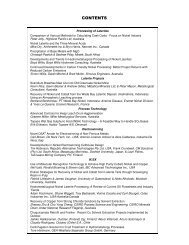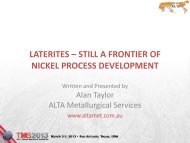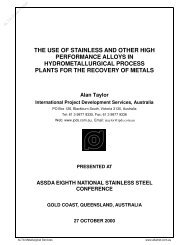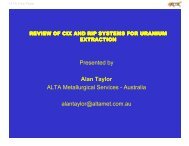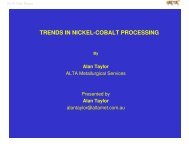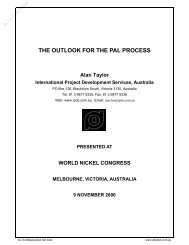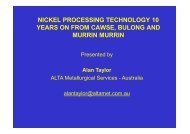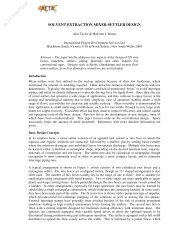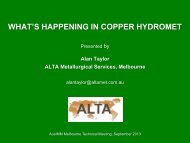Contents & Abstracts - ALTA Metallurgical Services
Contents & Abstracts - ALTA Metallurgical Services
Contents & Abstracts - ALTA Metallurgical Services
Create successful ePaper yourself
Turn your PDF publications into a flip-book with our unique Google optimized e-Paper software.
OPTIMIZING NICKEL LATERITE AGGLOMERATION FOR ENHANCED HEAP<br />
LEACHING<br />
By<br />
1 Jonas Addai-Mensah, 1 Ishmael Quaicoe, 1 Ataollah Nosrati, 2 George Franks, 2 Liza Forbes ,<br />
3 Lian Liu, 4 David J. Robinson and 4 John Farrow,<br />
1 Ian Wark Research Institute, University of South Australia, Australia<br />
2 Dept. Chemical and Bimolecular Engineering, University of Melbourne, Australia<br />
3 School of Chemical Engineering, University of Queensland, Australia<br />
4 CSIRO Process Science and Engineering & Minerals Down Under National Research Flagship<br />
Australian Minerals Research Centre, Australia<br />
Presenter<br />
Jonas Addai-Mensah<br />
Jonas.addai-mensah@unisa.edu.au<br />
ABSTRACT<br />
Although about 60 % of the world’s nickel (Ni) mineralization occurs as nickel laterite ore, processing<br />
of complex, low grade laterite ores by conventional physical unit operations (e.g. magnetic,<br />
electrostatic and flotation) is still intractable. Due to their mineralogical and chemical complexity, low<br />
grade nickel laterite ores require more aggressive chemical and hydrometallurgical techniques (e.g.,<br />
acidic lixiviant heap leaching) for value metal (Ni and Co) extraction. To process such ores,<br />
agglomeration of the feed particles into robust and porous granules as a precursor to heap leaching<br />
of 4-10 m permeable bed, is desirable. In the present work, we investigate agglomeration behaviour<br />
of siliceous goethite Ni laterite ore and selected oxides and clay minerals (hematite, quartz and<br />
kaolinite) which constitute the predominant host gangue phases of typical low grade nickel laterite<br />
ores. Fundamental knowledge and understanding of the agglomeration mechanisms and kinetics<br />
which are essential for producing robust real ore granules, and pivotal to the subsequent heap<br />
leaching process, are gleaned. Isothermal, batch agglomeration tests involving 30 and 44 wt.%<br />
sulphuric acid solution as a binder indicated that 5 – 40 mm granules of differing roughness and<br />
morphologies were produced in 8-14 min.<br />
The results clearly showed feed characteristics (such as mineralogy and primary particle size<br />
distribution) and binder content (15-25 wt.%) dependent agglomeration behaviour. Slow induction<br />
type nucleation and growth agglomeration were displayed by the kaolinite clay mineral whilst the<br />
oxides exhibited fast nucleation and growth agglomeration processes. Siliceous goethite feed ore<br />
fine/coarse ratio, H 2 SO 4 binder dosage and acidity, post-agglomeration drying temperature and<br />
aging conditions, all showed significant impact on controlling agglomeration mechanism (e.g.,<br />
particle wetting, nucleation and growth processes) and granule attributes (e.g., size, density and<br />
strength). Agglomerates strength and density increased with increasing fine/coarse particle ratio.<br />
108



